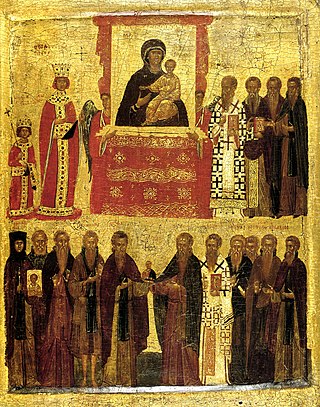
Iconoclasm is the social belief in the importance of the destruction of icons and other images or monuments, most frequently for religious or political reasons. People who engage in or support iconoclasm are called iconoclasts, a term that has come to be figuratively applied to any individual who challenges "cherished beliefs or venerated institutions on the grounds that they are erroneous or pernicious."

The Kosovo War was an armed conflict in Kosovo that lasted from 28 February 1998 until 11 June 1999. It was fought between the forces of the Federal Republic of Yugoslavia, which controlled Kosovo before the war, and the Kosovo Albanian rebel group known as the Kosovo Liberation Army (KLA). The conflict ended when the North Atlantic Treaty Organization (NATO) intervened by beginning air strikes in March 1999 which resulted in Yugoslav forces withdrawing from Kosovo.
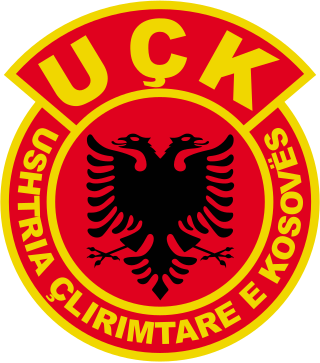
The Kosovo Liberation Army was an ethnic Albanian separatist militia that sought the separation of Kosovo, the vast majority of which is inhabited by Albanians, from the Federal Republic of Yugoslavia (FRY) and Serbia during the 1990s. Albanian nationalism was a central tenet of the KLA and many in its ranks supported the creation of a Greater Albania, which would encompass all Albanians in the Balkans, stressing Albanian culture, ethnicity and nation.
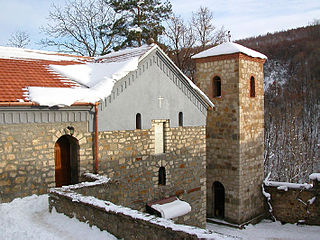
The Devič Monastery is a Serbian Orthodox abbey in Kosovo. It was built in 1434 and is dedicated to St Joanikije of Devič. Devič was declared Monument of Culture of Exceptional Importance in 1990, and it is protected by the Republic of Serbia.

The Christianization of sites that had been pagan occurred as a result of conversions in early Christian times, as well as an important part of the strategy of Interpretatio Christiana during the Christianization of pagan peoples. The landscape itself was Christianized, as prominent features were rededicated to Christian saints, sometimes quite directly, as when the island of Oglasa in the Tyrrhenian Sea was christened Montecristo.

Islam in Kosovo has a long-standing tradition dating back to the Ottoman conquest of the Balkans. Before the Battle of Kosovo in 1389, the entire Balkan region had been Christianized by both the Western and Eastern Roman Empire. From 1389 until 1912, Kosovo was officially governed by the Muslim Ottoman Empire and a high level of Islamization occurred among Catholic and Orthodox Albanians, mainly due to Sufi orders and socio-political opportunism. Both Christian and Muslim Albanians intermarried and some lived as "Laramans", also known as Crypto-Christians. During the time period after World War II, Kosovo was ruled by secular socialist authorities in the Socialist Federal Republic of Yugoslavia (SFRY). During that period, Kosovars became increasingly secularized. After the end of Communist period religion had a revival in Kosovo. Today, 95.6% of Kosovo's population are Muslims, most of whom are ethnic Albanians. There are also non-Albanian speaking Muslims, who define themselves as Bosniaks, Gorani and Turks.
Martyrdom in Judaism is one of the main examples of Jews doing a kiddush Hashem, a Hebrew term which means "sanctification of [the] name". An example of this is public self-sacrifice in accordance with Jewish practice and identity, with the possibility of being killed for no other reason than being Jewish. There are specific conditions in Jewish law that deal with the details of self-sacrifice, be it willing or unwilling.
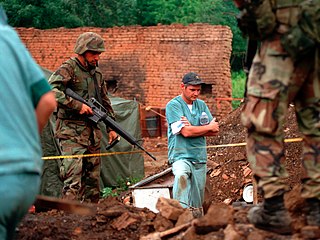
Numerous war crimes were committed by all sides during the Kosovo War, which lasted from 28 February 1998 until 11 June 1999. According to Human Rights Watch, the vast majority of abuses were attributable to the government of Slobodan Milošević, mainly perpetrated by the Serbian police, the Yugoslav army, and Serb paramilitary units. During the war, regime forces killed between 7,000–9,000 Kosovar Albanians, engaged in countless acts of rape, destroyed entire villages, and displaced nearly one million people. The Kosovo Liberation Army has also been implicated in atrocities, such as kidnappings and summary executions of civilians. Moreover, the NATO bombing campaign has been harshly criticized by human rights organizations and the Serbian government for causing roughly 500 civilian casualties.
Immovable Cultural Heritage of Exceptional Importance are those objects of Immovable cultural heritage that enjoy the highest level of state protection in the Republic of Serbia. Immovable Cultural Heritage is classified as being of Exceptional Importance upon decision by the National Assembly of Serbia. They are inscribed in the Central Register of Immovable cultural property maintained by the Institute for the Protection of Cultural Monuments of Serbia. Objects of Immovable cultural heritage have to fulfill one or more of those criteria defined in the Law on Cultural Heritage of 1994 in order to be categorized as being "of exceptional importance":
- exceptional importance for social, historical or cultural development of the people, or for the development of its natural environment;
- evidence of important historic events or persons and their work;
- unique (rare) example of human creativity of the time or a unique example from the natural history;
- great influence on the development of society, culture, technology, or science;
- exceptional artistic or aesthetic value.

Serbia was involved in the Yugoslav Wars, which took place between 1991 and 1999—the war in Slovenia, the war in Croatia, the war in Bosnia, and Kosovo. From 1991 to 1997, Slobodan Milošević was the President of Serbia. Serbia was part of the Federal Republic of Yugoslavia (FRY). The International Criminal Tribunal for the Former Yugoslavia (ICTY) has established that Milošević was in control of Serb forces in Bosnia and Herzegovina and Croatia during the wars which were fought there from 1991 to 1995.
Christianity in Kosovo has a long-standing tradition dating to the Roman Empire. The entire Balkan region had been Christianized by the Roman, Byzantine, First Bulgarian Empire, Serbian Kingdom, Second Bulgarian Empire, and Serbian Empire till 13th century. After the Battle of Kosovo in 1389 until 1912, Kosovo was part of the Muslim Ottoman Empire, and a high level of Islamization occurred. During the time period after World War II, Kosovo was ruled by secular socialist authorities in the Socialist Federal Republic of Yugoslavia (SFRY). During that period, Kosovars became increasingly secularized. Today, 90% of Kosovo's population are from Muslim family backgrounds, most of whom are ethnic Albanians, but also including Slavic speakers and Turks.
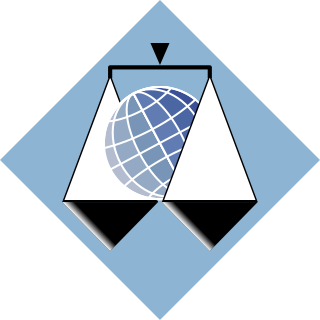
The war crimes trial of Slobodan Milošević, the former President of the Federal Republic of Yugoslavia, at the International Criminal Tribunal for the former Yugoslavia (ICTY) lasted for just over four years from 2002 until his death in 2006. Milošević faced 66 counts of crimes against humanity, genocide, and war crimes committed during the Yugoslav Wars of the 1990s. He pleaded not guilty to all the charges.

Kosovo is a partially recognized state and disputed territory located in the Balkan Peninsula in Southeastern Europe. The majority of Kosovars are ethnically Albanian. Kosovo has an expansive cultural heritage, including monuments, clothing items, museums, and traditional food.
Kosovo does not have an official religion. Like the rest of the country, the majority of Pristina's population consider themselves to be Muslim. However, religious practices may tend to be liberal. Many do fast for Ramadan and praying is widely practiced.
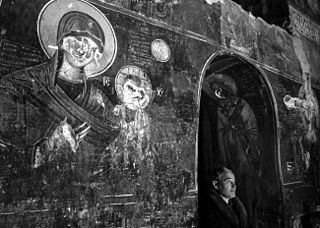
Serbian cultural and religious sites in Kosovo were systematically vandalized and destroyed over several historical periods, during the Ottoman rule, World War I, World War II, Yugoslav communist rule, Kosovo War and 2004 unrest.

The Church of the Holy Sepulchre, churches, synagogues, Torah scrolls and other non-Muslim religious artifacts and buildings in and around Jerusalem, were destroyed starting on 28 September 1009 on the orders of the Fatimid Caliph Al-Hakim bi-Amr Allah, known by his critics as "the mad Caliph" or "Nero of Egypt". His son, the Fatimid Caliph Al-Zahir, allowed the Byzantines to rebuild the Church of the Holy Sepulchre in 1027–28. The construction of a much diminished ensemble was wrapped up by 1048. This was the second of the two times the church was seriously damaged, the first being in 614 during the Byzantine–Sasanian War of 602–628.

The architectural heritage of the Kosovo Albanians during Yugoslav rule was shown institutionalised disregard for decades prior to outright conflict at the end of the 20th century. Numerous Albanian cultural sites in Kosovo were destroyed during the period of Yugoslav rule and especially the Kosovo conflict (1998-1999) which constituted a war crime violating the Hague and Geneva Conventions. In all, 225 out of 600 mosques in Kosovo were damaged, vandalised, or destroyed alongside other Islamic architecture during the conflict. Additionally 500 Albanian owned kulla dwellings and three out of four well-preserved Ottoman period urban centres located in Kosovo cities were badly damaged resulting in great loss of traditional architecture. Kosovo's public libraries, of which 65 out of 183 were completely destroyed, amounted to a loss of 900,588 volumes, while Islamic libraries sustained damage or destruction resulting in the loss of rare books, manuscripts and other collections of literature. Archives belonging to the Islamic Community of Kosovo, records spanning 500 years, were also destroyed. During the war, Islamic architectural heritage posed for Yugoslav Serb paramilitary and military forces as Albanian patrimony with destruction of non-Serbian architectural heritage being a methodical and planned component of ethnic cleansing in Kosovo.
András J. Riedlmayer, is American art historian. He studied at the University of Chicago and at Princeton University, where he lectured Ottoman history and Near Eastern Studies. He served as president of the Ottoman and Turkish Studies Association and as a member of the board of the Islamic Manuscript Association. He was director of the Documentation Center for Islamic Architecture of the Aga Khan Program at Harvard University's Fine Arts Library. He was expert witness for the Prosecution on the systematic destruction of cultural heritage in Bosnia and Herzegovina in 1992 and 1996, and destruction of cultural heritage of Kosovo in 1999, at the ICTY in the trials of Milošević, Šešelj, Karadžić.













